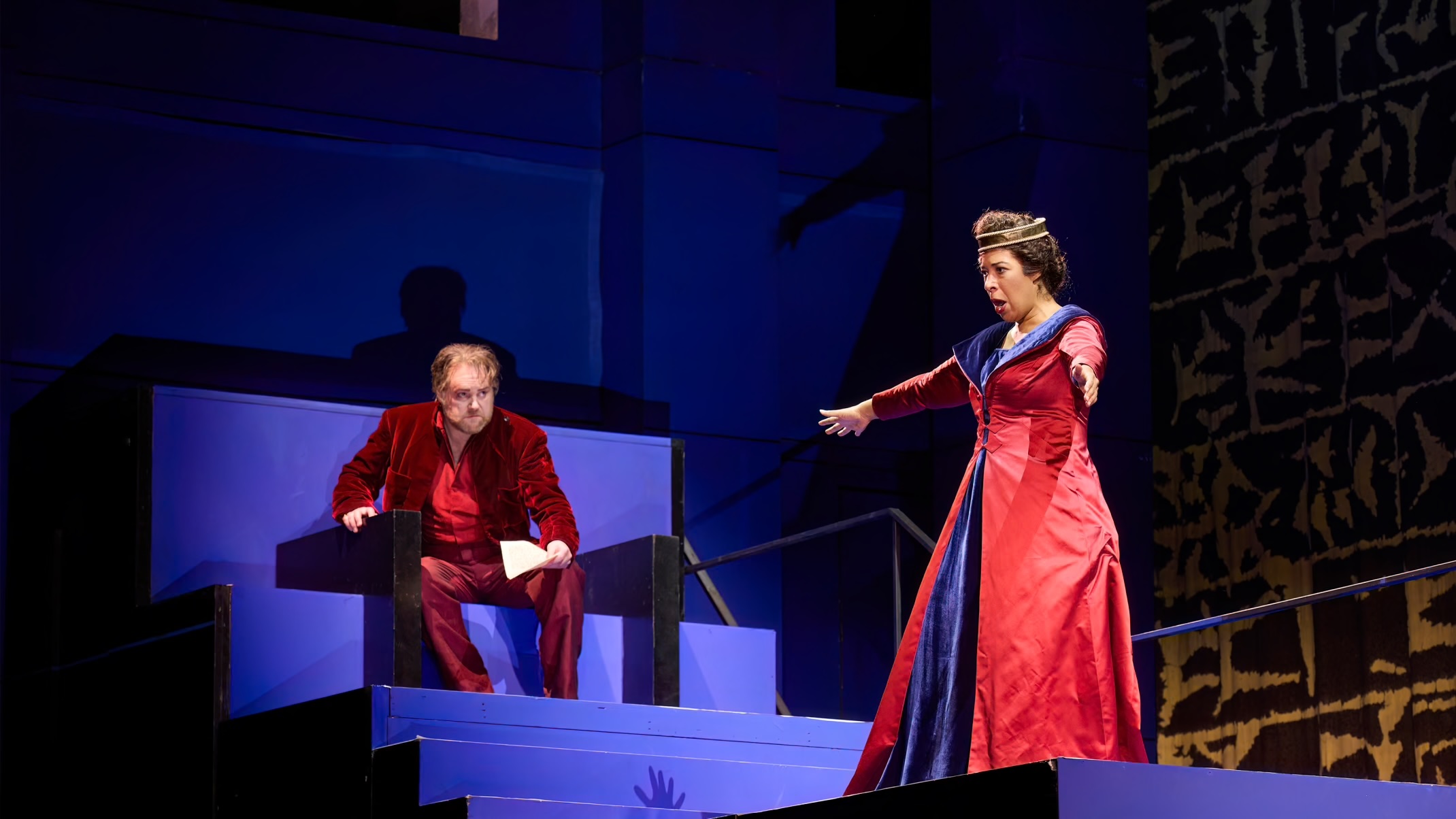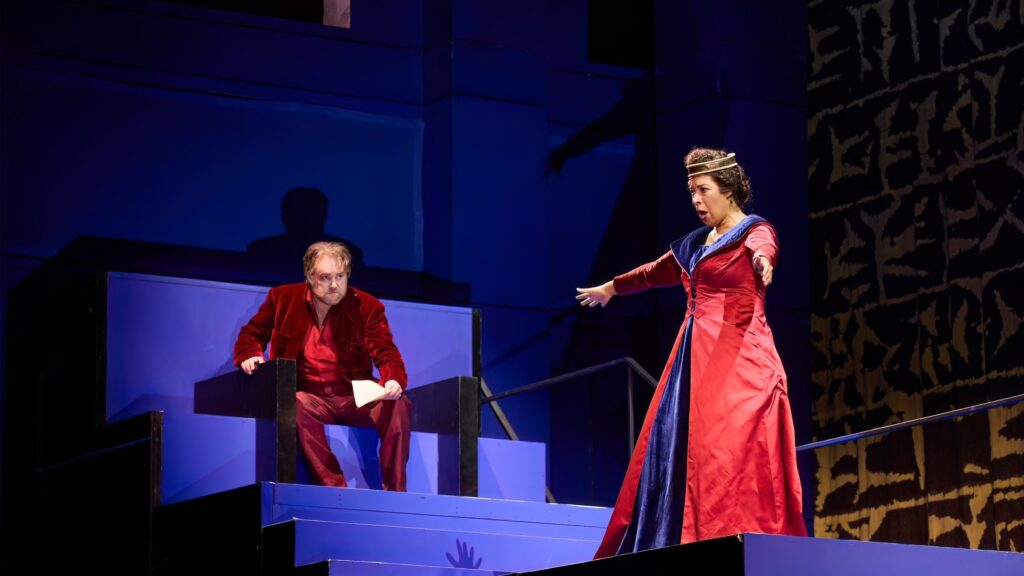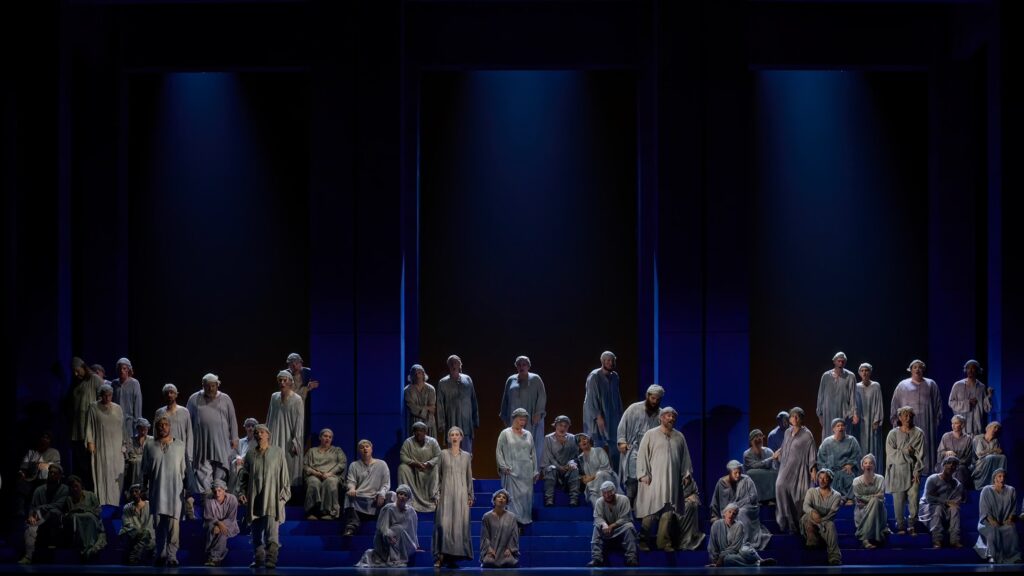

Canadian Opera Company / Nabucco, composed by Giuseppe Verdi, libretto by Temistocle Solera, conducted by Paolo Carignani, directed by Katherine M. Carter, Four Seasons Centre, closes Oct. 25.
The COC is mounting Verdi’s Nabucco for the first time in a splendid production borrowed from Lyric Opera of Chicago.
Verdi’s third opera premiered at La Scala in 1842 and was an instant international success. The composer himself acknowledged that Nabucco was the true start of his artistic career. The opera contains all the wonderful Verdiisms we have come to love – lyrical and/or exciting arias, duets, trios, and larger ensembles, and tuneful chorus after tuneful chorus. Among the latter is the much beloved “Chorus of the Hebrew Slaves” (“Va, pensiero, sull’ali dorate”), and the COC singers nailed it.
For many in the audience, this is their first Nabucco, so it is a very good thing that American director Katherine M. Carter chose a traditional approach. No Hamlet in Raincoats syndrome here.
As someone once said of early and middle Verdi, there is very little action because the singers are always explaining and/or telling something in a stand-and-deliver mode.
Following this dictum, Carter opted for simplicity, and the cast, both soloists and chorus, for the most part, stand and deliver. In the case of the chorus, Carter did play with patterns and shapes to break the monotony, and it worked – the Babylonians in rigid formation, and the Hebrews more loosely grouped. “The Chorus of the Hebrew Slaves” had random individual members making short sharp forward movements which mirrored their despair, until they were all massed at stage front for the chorus finale. It was very effective directing indeed.
Carter also, mercifully, did not put any stage visuals to the overture, so we were able to concentrate on the music-making of Italian Maestro Paolo Carignani and the COC orchestra, and collectively, they were superb.
Carignani is a detail man, with a careful attention to articulation and dynamics. He is not afraid to go slow, or fast, when required, and his build to a musical climax is perfection. Throughout the opera we heard all these individual strengths at play, and never did Carignani and his forces produce just a wall of sound amid the drama and tension of Verdi’s music. And it should be noted that Carignani had the good taste not to encore “Va, Pensiero” which I find shameless, and which interrupts the flow of the scene.
In short, both director Carter and conductor Carignani served the intentions of the composer and librettist, while never imposing their own egos on either the stage picture or the music.
The story of Nabucco is set in biblical times when the Hebrews were conquered by the Babylonians and the Temple destroyed. Within this larger framework, the libretto contains an intimate story.
Babylonian king Nabucco/Nebuchadnezzar (Scottish baritone Roland Wood) shows more favour to his younger daughter Fenena (Canadian mezzo-soprano Rihab Chaieb) over his older daughter Abigaille (American soprano Mary Elizabeth Williams). Two things rouse the vengeful Abigaille to usurp the throne. First she discovers that she is the daughter of a slave. Second, she loves the captured Hebrew Ismaele (Canadian tenor Matthew Cairns) who in turn, loves Fenena and spurns Abigaille. Another important character is High Priest Zaccaria (South Korean bass Simon Lim), leader of the Hebrews.

Rounding out the cast are the comprimario roles – Zaccaria’s sister Anna (Canadian soprano Charlotte Siegel), the High Priest of Baal (Canadian bass Duncan Stenhouse) and Babylonian officer Abdallo (Canadian tenor Wesley Harrison).
Because Nabucco is early Verdi, it falls squarely in the bel canto camp.
The role of Abigaille is a tortuous sing, and one designed to cause goosebumps. In fact, if Abigaille does not cause goosebumps, there is something radically wrong. A true bel canto soprano is a spinto, which is a heavier voice than a lyric soprano. She is one who has those gravely low notes and a towering top, not to mention coloratura chops – and Williams has all that and more. From the moment she opened her mouth, and out came notes somewhere down in her lower depths, I knew I had a bel canto soprano of my dreams.
Williams also pulled off the sweetest cavatina in her big aria “Anch’io dischiuso un giorno”, and brought the house down with the following ornamented cabaletta “Salgo già del trono aurato”. She is also a marvellous dramatic actor, particularly in her Act lll duet with Nabucco where she practically demolished the king and brought him to his knees. In short, what a find is Williams!
In the other major female role, Chaieb showed a hearty but lyrical mezzo. She has quite the stunning voice, at once sweet yet powerful, augmented by a warm stage presence. Definitely another keeper.
Both baritone Wood and bass Lim started off slowly for me. I wanted more force from both of them, but by the opera’s end, they had arrived where I wanted them to be with commanding presence. Wood really came alive in his duet with Abigaille, and his subsequent emotional mad scene, while Lim showed his moxie in revving up the Hebrews following their lament. Both have even, attractive voices with layers of colour.
Oddly, for a tenor in a Verdi opera, Cairns’ Ismaele had little to do, but he showed very attractive high notes and a rich middle register. At this point, he’s a baby tenor, but one of infinite promise. Besides that, he’s tall which just gilds the lily.
Overall, the cast is very strong and capable of great dramatic heights that matched Verdi’s luscious music.
And then there is the chorus, alternating between being Hebrews and Babylonians, but, nonetheless, singing their hearts out in sterling fashion. Swollen to 56 singers (from the usual COC 40), they too showed wonderful dynamics whether soft or rousing, and kudos to chorus master Sandra Horst for another sterling job in welding these voices together. Their “Chorus of the Hebrew Slaves” was rendered as a most touching and melancholy lament.
Set designer Michael Yeargan cleverly opted for simplicity with a series of stairs rising to meet a pillared platform. Costume designer Jane Greenwood used the motif of colours – Hebrews black in Jerusalem, and beige in captivity, and the Babylonians always in bright red. On the other hand, the costumes were a curious mix of ancient (the Hebrews) and modern (Babylonians), with the latter looking like they were in jumpsuits, which did jar a bit.
By the end of Nabucco, it was abundantly clear that the COC had a well-deserved triumph on its hands, and an excellent addition to the repertoire. This production is a bel canto dream come true.

